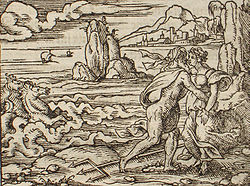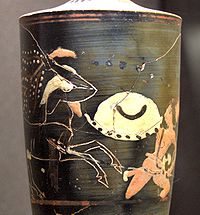
Caeneus
Encyclopedia

Greek mythology
Greek mythology is the body of myths and legends belonging to the ancient Greeks, concerning their gods and heroes, the nature of the world, and the origins and significance of their own cult and ritual practices. They were a part of religion in ancient Greece...
, Caeneus (Ancient Greek
Ancient Greek
Ancient Greek is the stage of the Greek language in the periods spanning the times c. 9th–6th centuries BC, , c. 5th–4th centuries BC , and the c. 3rd century BC – 6th century AD of ancient Greece and the ancient world; being predated in the 2nd millennium BC by Mycenaean Greek...
Καινεύς or Kaineus) was a Lapith
Lapith
The Lapiths are a legendary people of Greek mythology, whose home was in Thessaly, in the valley of the Peneus and on the mountain Pelion.They were an Aeolian tribe. Like the Myrmidons and other Thessalian tribes, the Lapiths were pre-Hellenic in their origins...
hero of Thessaly
Thessaly
Thessaly is a traditional geographical region and an administrative region of Greece, comprising most of the ancient region of the same name. Before the Greek Dark Ages, Thessaly was known as Aeolia, and appears thus in Homer's Odyssey....
and, in Ovid
Ovid
Publius Ovidius Naso , known as Ovid in the English-speaking world, was a Roman poet who is best known as the author of the three major collections of erotic poetry: Heroides, Amores, and Ars Amatoria...
's Metamorphoses
Metamorphoses (poem)
Metamorphoses is a Latin narrative poem in fifteen books by the Roman poet Ovid describing the history of the world from its creation to the deification of Julius Caesar within a loose mythico-historical framework. Completed in AD 8, it is recognized as a masterpiece of Golden Age Latin literature...
— where the classical model of a hero is deconstructed and transformed— originally a woman, Caenis, daughter of Atrax
Atrax (mythology)
In Greek mythology, Atrax was the son of the river god Peneus and Bura. He was believed to have been the founder and eponym of Atrax or Atracia, a city in Thessaly...
. Such warrior women, indistinguishable from men, were familiar among the Scythian horsemen too (see the entry "Amazons
Amazons
The Amazons are a nation of all-female warriors in Greek mythology and Classical antiquity. Herodotus placed them in a region bordering Scythia in Sarmatia...
") and survive among Albanian traditions as the "sworn virgin
Sworn virgin
A sworn virgin is a person who decides to live in the manner of the opposite sex while adamantly refusing ever to have sexual relations with another. The term itself can be misleading — "swearing" virginity can be a public or private act, and it does not even have to be a conscious decision...
s" (virgjinesha,).
In Apollonius of Rhodes
Apollonius of Rhodes
Apollonius Rhodius, also known as Apollonius of Rhodes , early 3rd century BCE – after 246 BCE, was a poet, and a librarian at the Library of Alexandria...
' Argonautica, where there is no inkling of his transgender, he was briefly noted as the great father of a lesser son, Coronus
Coronus
-Greek mythology:*Coronus' the son of Caeneus. He was one of the Lapiths and was killed by Heracles.*Coronus, king of Sicyon, son of Apollo and Chrysorthe, and father of Lamedon and Corex. He was deposed by Epopeus.*Coronus, son of Thersander...
, who sailed forth among the Argonauts
Argonauts
The Argonauts ) were a band of heroes in Greek mythology who, in the years before the Trojan War, accompanied Jason to Colchis in his quest to find the Golden Fleece. Their name comes from their ship, the Argo, which was named after its builder, Argus. "Argonauts", therefore, literally means...
. The striking mythic image of this hero is that, indomitable through his more-than-human power, his enemies the Centaur
Centaur
In Greek mythology, a centaur or hippocentaur is a member of a composite race of creatures, part human and part horse...
s resorted to driving him into the ground with timbers.
they could neither force him to yield, nor yet dispatch him,
but unbowed, unbroken, he went into earth down under,
crushed by a shattering hail of heavy pine trunks.
Myth

Centaur
In Greek mythology, a centaur or hippocentaur is a member of a composite race of creatures, part human and part horse...
s (see Pirithous
Pirithous
In Greek mythology, Pirithous - Πειρίθοος was the King of the Lapiths in Thessaly and husband of Hippodamia, at whose wedding the famous Battle of Lapiths and Centaurs occurred....
). Similarly, in the Iliad
Iliad
The Iliad is an epic poem in dactylic hexameters, traditionally attributed to Homer. Set during the Trojan War, the ten-year siege of the city of Troy by a coalition of Greek states, it tells of the battles and events during the weeks of a quarrel between King Agamemnon and the warrior Achilles...
(without referring to these transformations) Nestor numbers Caeneus among an earlier generation of heroes of his youth, "the strongest men that Earth has bred, the strongest men against the strongest enemies, a savage mountain-dwelling tribe whom they utterly destroyed."
In Ovid's description of the tale, a particular centaur, Latreus, mocks Caeneus and denies his skill as a fighter when he realizes Caeneus' female origin. Caeneus strikes Latreus a blow in the side, and is unharmed by the centaur's last attempts at wounding him. In revenge for this, the centaurs piled pine-tree trunks (some say fir trees) and stones upon him, since he was immune to weapons.
There are several descriptions of Caeneus' fate after he had been crushed down by the trunks. One vase, for instance, depicts him as sinking down into the earth, upright, and buried at the waist; this legend is described in the Metamorphoses
Metamorphoses (poem)
Metamorphoses is a Latin narrative poem in fifteen books by the Roman poet Ovid describing the history of the world from its creation to the deification of Julius Caesar within a loose mythico-historical framework. Completed in AD 8, it is recognized as a masterpiece of Golden Age Latin literature...
as well, and implies that Caeneus is falling directly into Tartarus
Tartarus
In classic mythology, below Uranus , Gaia , and Pontus is Tartarus, or Tartaros . It is a deep, gloomy place, a pit, or an abyss used as a dungeon of torment and suffering that resides beneath the underworld. In the Gorgias, Plato In classic mythology, below Uranus (sky), Gaia (earth), and Pontus...
. Ovid states that Caeneus flew away from the pile of tree trunks as a golden-winged bird. This version of the ending his given two witnesses, Mopsus
Mopsus
Mopsus or Mopsos was the name of two famous seers in Greek mythology. A historical/legendary Mopsus was the founder of a house in power at widespread sites in the coastal plains of Pamphylia and Cilicia during the early Iron Age.-Son of Manto and Rhacius or Apollo:Mopsus, a celebrated seer and...
and the "son of Ampycus
Ampyx
Ampyx has several meanings; in hair care, an ampyx is a headband, often made of metal. In Greek mythology, there were a number of figures with the name Ampyx, Amycus or Ampycus ....
", as well as Nestor
Nestor (mythology)
In Greek mythology, Nestor of Gerenia was the son of Neleus and Chloris and the King of Pylos. He became king after Heracles killed Neleus and all of Nestor's siblings...
, who tells the story.
Caenis/Caeneus' legend is found in Ovid's Metamorphoses
Metamorphoses (poem)
Metamorphoses is a Latin narrative poem in fifteen books by the Roman poet Ovid describing the history of the world from its creation to the deification of Julius Caesar within a loose mythico-historical framework. Completed in AD 8, it is recognized as a masterpiece of Golden Age Latin literature...
, where he is mentioned briefly as a participant in the hunt for the Calydonian Boar
Calydonian Boar
The Calydonian Boar is one of the monsters of Greek mythology that had to be overcome by heroes of the Olympian age. Sent by Artemis to ravage the region of Calydon in Aetolia because its king failed to honor her in his rites to the gods, it was killed in the Calydonian Hunt, in which many male...
. A while after this appearance, Nestor tells the story of Caeneus to Achilles in fuller detail, describing his transformation from female to male. In Ovid
Ovid
Publius Ovidius Naso , known as Ovid in the English-speaking world, was a Roman poet who is best known as the author of the three major collections of erotic poetry: Heroides, Amores, and Ars Amatoria...
's retelling, placed in the mouth of the aged Homeric hero Nestor, Caenis, the daughter of Elatus
Elatus
There were eight figures named Elatus or Élatos in Greek mythology.* Elatus, a Lapith chieftain, was the father, by Hippeia, of:**Ischys who was beloved by Coronis...
(a Lapith chieftain) and Hippea
Hippeia
-Athena Hippeia :Athena Hippeia is Athena as a goddess of horses. In this form, she was said to be the daughter of Poseidon and Polyphe, daughter of Oceanus. She was given her name because she was the first to use a chariot....
, was raped by Poseidon
Poseidon
Poseidon was the god of the sea, and, as "Earth-Shaker," of the earthquakes in Greek mythology. The name of the sea-god Nethuns in Etruscan was adopted in Latin for Neptune in Roman mythology: both were sea gods analogous to Poseidon...
, who then fulfilled her request to be changed into a man so that she could never be raped again; he also made Caenis invulnerable to weaponry. Caenis then changed his name to Caeneus and became a warrior, traveling all over Thessaly, and later taking part in the hunt for the Calydonian Boar
Calydonian Boar
The Calydonian Boar is one of the monsters of Greek mythology that had to be overcome by heroes of the Olympian age. Sent by Artemis to ravage the region of Calydon in Aetolia because its king failed to honor her in his rites to the gods, it was killed in the Calydonian Hunt, in which many male...
.
Virgil
Virgil
Publius Vergilius Maro, usually called Virgil or Vergil in English , was an ancient Roman poet of the Augustan period. He is known for three major works of Latin literature, the Eclogues , the Georgics, and the epic Aeneid...
also says that Aeneas
Aeneas
Aeneas , in Greco-Roman mythology, was a Trojan hero, the son of the prince Anchises and the goddess Aphrodite. His father was the second cousin of King Priam of Troy, making Aeneas Priam's second cousin, once removed. The journey of Aeneas from Troy , which led to the founding a hamlet south of...
sees her/him in the Fields of Mourning as he visits the underworld in Book Six of the Aeneid
Aeneid
The Aeneid is a Latin epic poem, written by Virgil between 29 and 19 BC, that tells the legendary story of Aeneas, a Trojan who travelled to Italy, where he became the ancestor of the Romans. It is composed of roughly 10,000 lines in dactylic hexameter...
. Caeneus has by now been turned back by Fate into her original female form. He was also mentioned in the Hesiodic Catalogue of Women
Catalogue of Women
thumb|275px|[[Guido Reni]]'s first Atalanta e Ippomene , depicting the race of [[Atalanta]], a myth which was known to Reni from [[Ovid]]'s [[Metamorphoses]], but is now also represented by several fragments of the Catalogue of Women.The Catalogue of Women —also known as...
.

